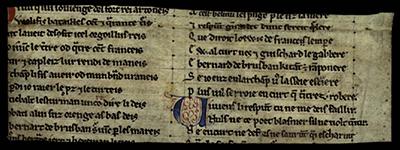Rare manuscript discovery illuminates history
Fragments of two medieval French epic poems have been discovered by researchers at the University of Edinburgh and the University of Bristol.

The larger of the two fragments has been identified as a section of text from the Chanson de Guillaume, one of the earliest surviving Old French texts. This dates from the late 13th century and, until now, was known in only one manuscript.
The smaller fragment comes from the late twelfth-century poem, Foulque de Candie, with the manuscript itself dating from the first half of the 14th century.
The fragments, each roughly the size and dimensions of a cheque, were found in a box of manuscript fragments recovered from book bindings in St Andrews University Library.
Both are written in Anglo-Norman orthography, meaning that they had been copied in England. The handwriting and page layout of the Chanson de Guillaume fragment is very similar to that of a manuscript of narrative texts in Oxford’s Bodleian Library known as Douce 132.
The University of Edinburgh’s Professor Philip Bennett, who helped identify the fragments, said: “It is probable that Douce 132 and the first fragment came from the same scriptorium or from closely related scriptoria in the Oxford area.
“The second fragment might be a conscious attempt to reproduce the work of what is revealed as a prestigious scriptorium - or the owner of the first fragment, who knew that his text should have Foulque de Candie to complete it, had a manuscript of the poem prepared in what was meant to be a complementary style.”
Dr Marianne Ailes of the University of Bristol said: “The significance of these fragments is out of proportion to their size. As they are written with the spelling characteristic of Anglo-Norman texts they add to our understanding of the reception of this kind of text in England.
“Differences between this manuscript of the Chanson de Guillaume and the only complete manuscript also help us to appreciate the way texts were altered; in one case the addition of a detail links it to the text in the other fragment. Professor Bennett and I are also investigating possible links with two other manuscripts.”

